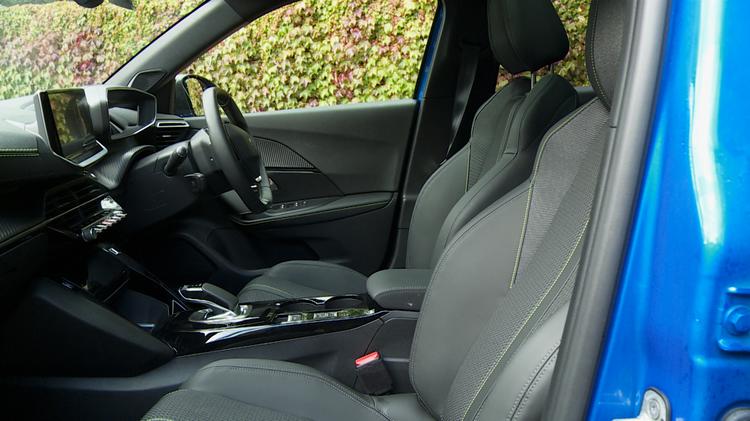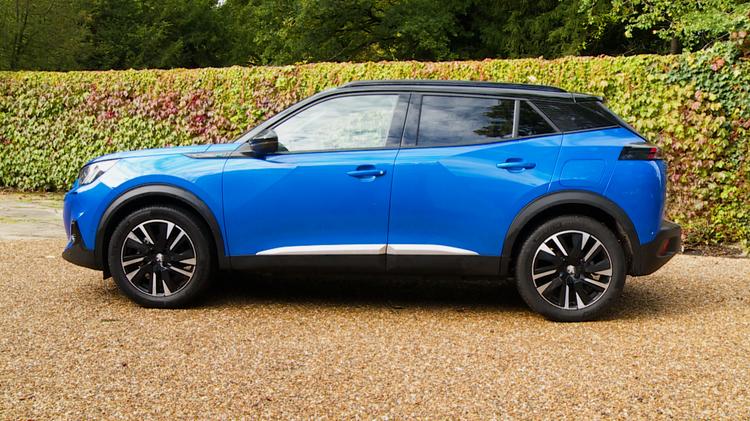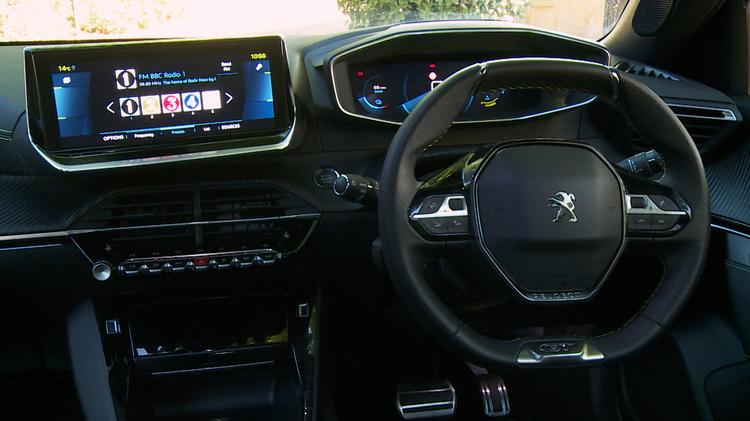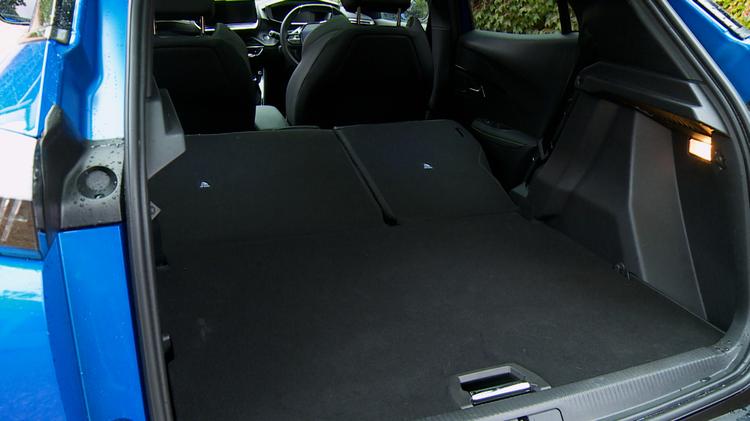Jonathan Crouch looks at the latest version of the e-2008, the all-electric variant of Peugeot's 2008 small SUV. It's recently been usefully updated.
Peugeot's e-2008 delivers the full-EV formula to the smallest segment of the SUV market - and in a trendy, very lifestyle-orientated package. It looks snappy and now thanks to a few tech updates does up to 212 miles between charges. Plus it has no practicality downsides over the combustion-engined version and comes with monthly payment finance you could justify. In short, there's plenty to like.
The e-2008 small SUV was Peugeot's second full electric model, introduced in 2020 as the brand implemented its strategy of providing an electrified derivative of every one of its cars. It's introduction was part of the company's philosophy of 'Unboring the Future' by offering customers the option of switching to a full-electric powertrain without compromising on space, technology, looks or driving sensation.
It shares all the same engineering we've already also seen in the Stellantis Group's other small battery-powered lifestyle SUVs, the DS 3 E-TENSE and the Vauxhall Mokka Electric, designs that, like this one, share this Peugeot's sophisticated CMP ('Common Modular Platform'). Plus those same underpinnings allow for a new generation of 'big car'-style camera safety systems. It all sounds promising, particularly as recently updates have marginally improved efficiency: let's take a look.
The tech spec here has been subtly finessed in recent times, with the key improvement being the installation of a completely new 54kWh battery, which has boosted EV range from 214 miles up to 252 miles. There's 18% more power for the electric motor it drives too, that output now up to 153bhp.
Otherwise, things are much as they were with the e-2008. That electric motor works through the usual single-speed auto transmission you get with EVs. As usual with a battery-powered model, all of the available torque is pretty much developed at once (there's 260Nm of it) and this car simply hurls itself away from rest (it takes just a couple of seconds to crest the 30mph mark and 60mph is reached in only 8.5s), disguising the fact that (also like all EVs) this Zero Emissions variant has a bit of a weight problem - that drivetrain adds over 300kgs of bulk. On top of that, this model's latest 54kWh lithium-ion battery is still significantly smaller than the 64kWh one you'll find in, say, a Kia Niro EV or a Hyundai Kona Electric, which accounts for the fact that this French EV crossover can't travel quite as far on a single charge as those two rivals.
Of course, you certainly won't achieve anything like the quoted level of operating capability if you get anywhere near this EV's quoted 93mph top speed. Or if you habitually drive your e-2008 in the 'Sport' setting that'll be necessary to release to full 153bhp power output we mentioned earlier. The quoted range figure will only be distantly possible if you instead engage a somewhat restrictive 'Eco' mode that drops power output right down to 83bhp. That's the setting you'll use in an e-2008 around town, an environment in which it makes a strange polyphonic sound at low speeds to warn unwary pedestrians of its impending approach. Above 18mph, all you can hear is a bit of tyre roar from the eco-moulded Michelin rubber.
The all-electric e-2008 is pretty difficult to distinguish from what Peugeot calls its 'thermic'-powered models, though brand loyalists might spot this EV variant's colour-coded front grille, subtle 'e'-badging and a more unusual 'Dichroic' finish for the lion badge that appears to change colour, depending on your viewing angle. Not too much is different about this revised model, which gains a slightly more aggressive front end, complete with the latest Peugeot brand badge and a light signature inspired by the recently revised 508, characterised by three vertical light claws integrated into the gloss black inserts on the bumper. There are revised LED tail lights too, made up of three super-imposed horizontal double slats, which help to visually widen the car's stance. Wheel sizes are between 16 and 18-inchers and, as before, the top GT-spec models are distinguished by a black bi-tone roof.
There are subtle differences inside with this revised model, where the innovative 'i-Cockpit' dash design (which sees you viewing the instrument gauges over the rim of the steering wheel rather than through it) has been updated, primarily with a fresh look for the 10-inch digital instrument cluster, which features a 3D display on the GT version. All models get a 10-inch central touchscreen as standard. The steering wheel gets new brand badging and houses buttons for the infotainment system, as well as the voice control set-up. Plus there are new upholstery and dash fabrics used throughout, including a smart alcantara option for the GT version.
Otherwise, things are much as before. The cabin's pretty practical; even with a six-foot tall driver up-front, someone of similar height could sit behind comfortably. And this interior continues to set the class standard for cabin quality, with more soft-touch surfaces than you'll find in the various rival Volkswagen Group small SUVs. There's a 434-litre boot with a false floor that can be positioned to create additional space beneath. The capacity is just like any other 2008 and extendable to 1,467-litres with the back seat folded.
Peugeot obviously thinks it's going to sell quite a few e-2008s (the prediction is 20% of total model mix) because this powertrain is available with every trim level - there are three - 'Active', 'Allure' and 'GT'. Prices start at just over £36,000 and run up to just under £42,000. That puts this Peugeot in exactly the same ballpark as direct comparably-sized rivals like the Kia Niro EV and the Hyundai Kona Electric.
As before, Peugeot expects the 'GT' variant to be particularly popular; this comes with 18-inch diamond-cut alloy wheels, LED headlamps, a black tailgate spoiler, a contrasting black roof, a dark chrome radiator grille and a sporty body kit with a matte chrome chin spoiler and a faux diffuser.
On 'Allure' trims and above, the 2008 is available with Peugeot's 'i-Connect' infotainment system, which offers full connectivity through wireless phone mirroring ('Apple CarPlay'/'Android Auto'). The system can be controlled via the central 10-inch high-definition touchscreen or via natural voice recognition, activated by saying 'Ok Peugeot'. The 'i-Connect Advanced' system is available as an option across the range, which adds a high-performance TomTom connected navigation system with over-the-air updates.
For easier and safer driving, the 2008 comes with a range of driver assistance features, including Adaptive Cruise Control with Stop & Go, Automatic Emergency Braking, Extended Traffic Sign Recognition, Lane Keeping Assist, Driver Attention Alert and Blind Spot Monitoring. For enhanced traction, Advanced Grip Control, together with all-season tyres, is also offered, which provides access to three additional driving modes: Sand, Mud and Snow.
Peugeot's aim was for this all-electric SUV to have a total ownership cost roughly equivalent to what you'd pay to buy and run an automatic version of the petrol model: well it's some way of that right at present. Its drivetrain claims to be state-of-the-art for a small crossover, though its WLTP-certified range (quoted at up to 252 miles) is still bettered by popular EV class choices like the Volkswagen ID.3 and the Skoda Enyaq iV. Bear in mind that as with all EVs, the quoted range figure will drop considerably in winter weather or over long motorway journeys. If you're an e-2008 owner, you'll need to know that getting anywhere near the quoted range figure will necessitate staying in the powertrain's provided 'Eco' mode - activating its 'Sport' mode setting will reduce your range by around 10%.
What about charging your e-2008? With a wallbox in place in your garage, a full charge from empty will take seven and-a-half hours - or four and three-quarter hours with the optional 11kW on-board charger fitted. With the standard on-board charger and hooked up to a public 50kW Rapid Charger, the replenishment time to charge from 15 to 80% is 45 minutes. If you're fortunate enough to find a 100kW Rapid Charger, that falls to 30 minutes. At the other extreme, if you happen to be somewhere you can only charge from a domestic supply using an ordinary 3-pin plug (and the optional 3-pin plug lead that costs extra with this car), the charging replenishment time would be a yawning 20 hours. As an e-2008 buyer, your dealer will also give you the option to pay a subscription for a so-called 'Mobility Pass'. That'll enable you to borrow a conventional petrol or diesel-powered car from the brand for those times when you might need to undertake a longer or more complex journey - holiday times for instance.
You can see why someone might really like the idea of an e-2008. It has all the style of Peugeot's e-208 supermini but with a significant amount of extra practicality. It's considerably more stylish than similarly-sized EV Crossover rivals from Kia and Hyundai. But you've still really got to be bought into the whole idea of having an EV to want one.
Even if you are, you've still got to like quirky Peugeot innovations like the unusual 'i-Cockpit' steering wheel and the 3D instrument set-up, but we think cars like this one need design touches of that sort. Models of this kind ought to be fashionable, forward-thinking and just a little controversial. The e-2008 is: if you are too and you can afford to make the price jump to a full-EV, we think you'll like it a lot.






